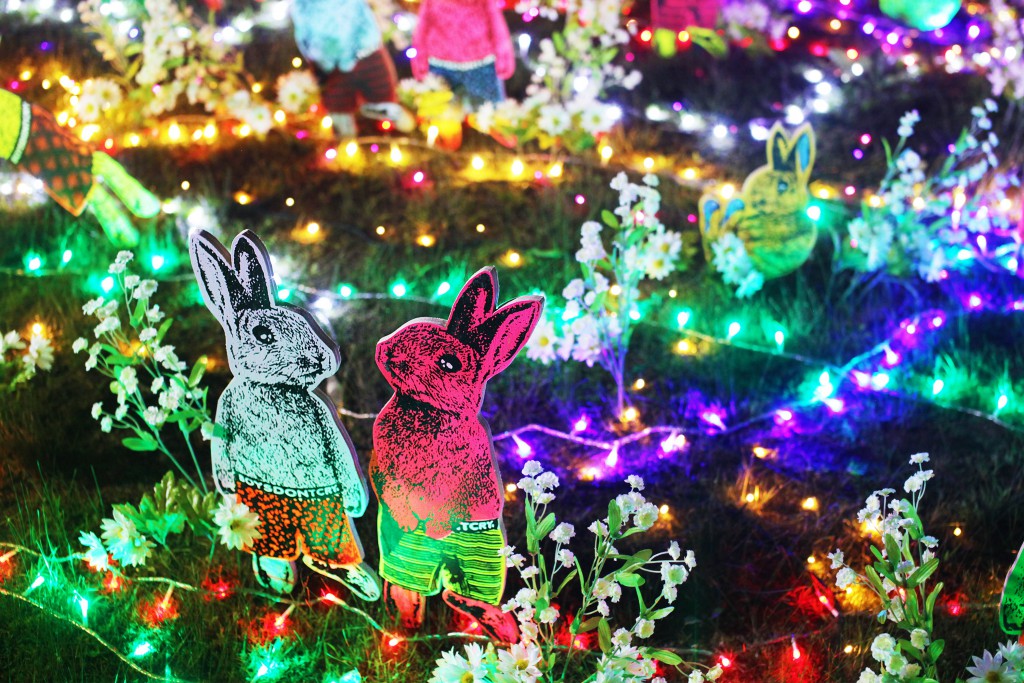Madbunny: Enduring Symbol of Fuji Rock
- June 29, 2022 ● From Fujirockers.org

Happy Bunny Couple
For Fuji Rock veterans, these playful, brightly colored bunnies are synonymous with the best festival moments such as a stroll along the boardwalk or the carefree feeling of listening to great music with a group of friends. The story of how these bunnies found their way to Naeba and later, in the middle of the iconic yellow towel freely distributed by Tower Records is well worth a quick read.
First of all, the man behind this distinctive design is Akiyoshi “Bunny” Takada . He’s from the nearby Gunnma Prefecture, and as a result, his first passion was snowboarding and then skateboarding. His passion for extreme sports and art took him overseas where he spend much of his time nowadays. Still, for a few months each year he returns to Naeba to install bunnies along the boardwalk and a crazed “Bunny Garden” near the Orange Court. Bunnies have even been spotted in some inconspicuous spots in the form of stickers posted on street signs and even in the immigration queue at Narita Airport.
During the festival, he can be hard to spot, either tending to his bunnies installations or hiding behind a camera as he’s an accomplished photographer with three published photo books. His art as led him largely to a career overseas with exhibits in capitals such as London and Berlin where he continues to split time. It was actually the Fukushima earthquake and tsunami that led him to think of his home in Japan, inspiring his “Hope” installation at APART London Summer Show (2011). This exhibition which attracted the attention of Fuji Rock’s UK art team as he was invited to do a project specifically for Fuji Rock’s boardwalk.
Initially, he had few expectations in the beginning, deciding to deploy his playful Madbunny which been in existence a few years earlier. The only spin he put on the project was his belief that the boardwalk area would be suitable for children, and putting animals in the forest would be visually interesting, thus leading to a more realistic design. Soon, a stencil was created leading to different colorways and black outline and a hand jigsaw to shape each character. With just 4 days before the festival opened, he produced just 44 bunnies.
An instant hit, he following year, the number of new bunnies jumped to more than 100, and then 220. They are produced on site in Naeba typically about 10-days before the festival. A breakthrough came when Tower Records who adopted his character as part of the “NO, FUJIROCK, NO LIFE!” project which coincided with the 20th anniversary of the festival. The partnership carried over to on-site distraction of towels, and sales of merchandise ranging from t-shirts, ponchos, and other items emblazoned with a bunny image.
On every bunny image one will notice the letters “BYSDNTCRY.” It’s the name the artist gives his art activities, which started in London, Berlin, Paris in 2008. It applies to his art works, apparel, books, etc. He envisions it more like a label for expressing your artwork than a brand. And yes, it is a song title from The Cure which he listens to along with a healthy does of Joy Division, Sex Pistols and Clash. He says he’s been influenced by these UK bands since his youth, even going so far as to picking up the guitar for the past 20 years.
As an artist, he desires to remove himself from his works and is delighted that children find his work fascinating on the boardwalk. With the number of bunnies increasing, travel times on the boardwalk have slowed, even creating a traffic jam due to people stopping for photos. There is a dark side to the bunny story, as more than 30 bunnies were stolen in one particular year. Festival organizer have put the word out that bunny is to remain in the forest, and after this public awareness campaign went into effect, less than 10 bunnies were lost proving that Fujirockers are very respectful.

Bunny brightens up at night
Gonchan, or the painted rocks found in riverbeds and other parts of the festival, are free to go home with festival goers only on the final day of the festival. And generally speaking, most people are happy to help out in this manner, as finding one in the wild after the festival is nearly impossible.
Visual artists have been an important part of Fuji Rock for the past two decades. These artists help the audience imagine the festival as being much more than music and more of an experience where art activities enhance their overall experience.
Text: Sean Scanlan
Photo credit: Akiyoshi “MADBUNNY” Takada



